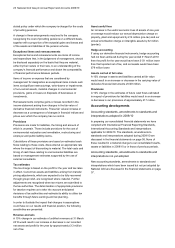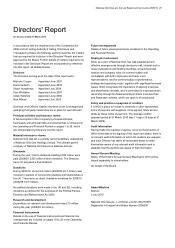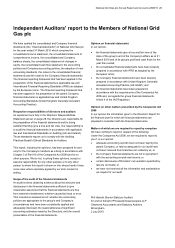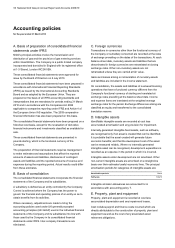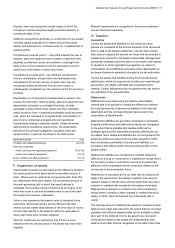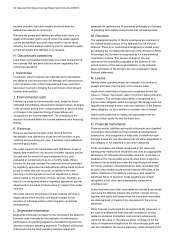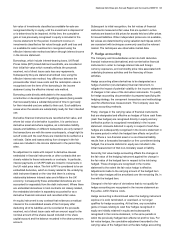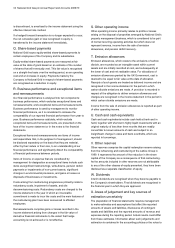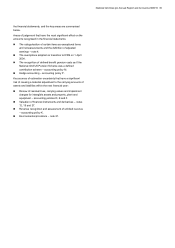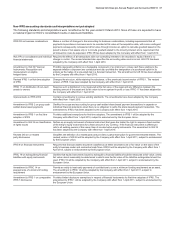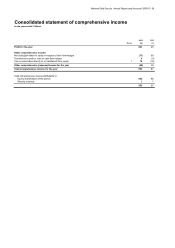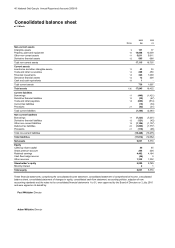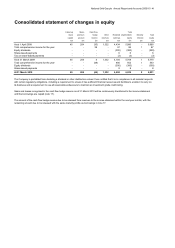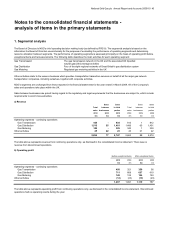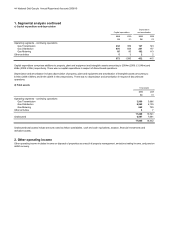National Grid 2010 Annual Report Download - page 36
Download and view the complete annual report
Please find page 36 of the 2010 National Grid annual report below. You can navigate through the pages in the report by either clicking on the pages listed below, or by using the keyword search tool below to find specific information within the annual report.34 National Grid Gas plc Annual Report and Accounts 2009/10
is discontinued, is amortised to the income statement using the
effective interest rate method.
If a hedged forecast transaction is no longer expected to occur,
the net cumulative gain or loss recognised in equity is
transferred to the income statement immediately.
Q. Share-based payments
National Grid issues equity-settled share-based payments to
certain employees of the Company and its subsidiaries.
Equity-settled share-based payments are measured at fair
value at the date of grant based on an estimate of the number
of shares that will eventually vest. This fair value is recognised
on a straight-line basis over the vesting period, as an operating
cost and an increase in equity. Payments made by the
Company to National Grid in respect of share-based payments
are recognised as a reduction in equity.
R. Business performance and exceptional items
and remeasurements
Our financial performance is analysed into two components:
business performance, which excludes exceptional items and
remeasurements; and exceptional items and remeasurements.
Business performance is used by management to monitor
financial performance, as it is considered to increase the
comparability of our reported financial performance from year to
year. Business performance subtotals, which exclude
exceptional items and remeasurements, are presented on the
face of the income statement or in the notes to the financial
statements.
Exceptional items and remeasurements are items of income
and expenditure that, in the judgment of management, should
be disclosed separately on the basis that they are material,
either by their nature or their size, to an understanding of our
financial performance and significantly distort the comparability
of financial performance between periods.
Items of income or expense that are considered by
management for designation as exceptional items include such
items as significant restructurings, write-downs, pension deficit
payments or impairments of non-current assets, significant
changes in environmental provisions, and gains or losses on
disposals of businesses or investments.
Costs arising from restructuring programmes primarily relate to
redundancy costs, impairment of assets, and site
decommissioning costs. Redundancy costs are charged to the
income statement in the year in which an irrevocable
commitment is made to incur the costs and the main features of
the restructuring plan have been announced to affected
employees.
Remeasurements comprise gains or losses recorded in the
income statement arising from changes in the fair value of
derivative financial instruments to the extent that hedge
accounting is not achieved or is not effective.
S. Other operating income
Other operating income primarily relates to profits or losses
arising on the disposal of properties arranged by National Grid’s
property management business, which is considered to be part
of normal recurring operating activities but which does not
represent revenue, income from the sale of emission
allowances, and pension deficit recovery.
T. Emission allowances
Emission allowances, which relate to the emissions of carbon
dioxide, are recorded as an intangible asset within current
assets and are initially recorded at cost, and subsequently at
the lower of cost and net realisable value. For allocations of
emission allowances granted by the UK Government, cost is
deemed to be equal to fair value at the date of allocation.
Receipts of such grants are treated as deferred income and are
recognised in the income statement in the period in which
carbon dioxide emissions are made. A provision is recorded in
respect of the obligation to deliver emission allowances and
charges are recognised in the income statement in the period in
which carbon dioxide emissions are made.
Income from the sale of emission allowances is reported as part
of other operating income.
U. Cash and cash equivalents
Cash and cash equivalents include cash held at bank and in
hand, together with short-term highly liquid investments with an
original maturity of less than three months that are readily
convertible to known amounts of cash and subject to an
insignificant change in value and bank overdrafts, which are
reported in borrowings.
V. Other reserves
Other reserves comprise the capital redemption reserve arising
from the refinancing and restructuring of the Lattice Group in
1999. It represents the amount of the reduction in the share
capital of the Company as a consequence of that restructuring.
As the amounts included in other reserves are not attributable
to any of the other classes of equity presented, they have been
disclosed as a separate classification of equity.
W. Dividends
Interim dividends are recognised when they become payable to
the Company’s shareholders. Final dividends are recognised in
the financial year in which they are approved.
X. Areas of judgement and key sources of
estimation uncertainty
The preparation of financial statements requires management
to make estimates and assumptions that affect the reported
amounts of assets and liabilities, disclosures of contingent
assets and liabilities and the reported amounts of revenue and
expenses during the reporting period. Actual results could differ
from these estimates. Information about such judgements and
estimation is contained in the accounting policies or the notes to




